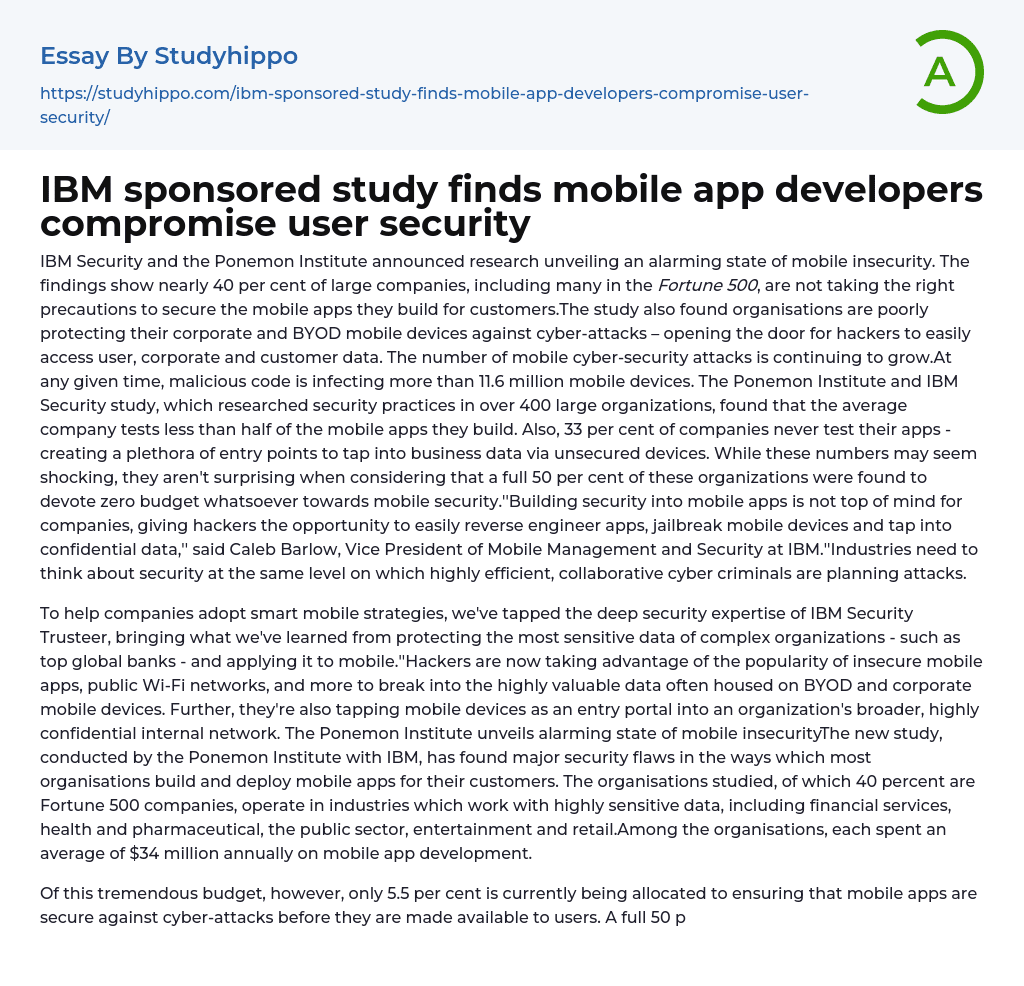

IBM sponsored study finds mobile app developers compromise user security Essay Example
Research conducted by IBM Security and the Ponemon Institute has unveiled a worrisome level of insecurity in the mobile space. The findings suggest that nearly 40 percent of large companies, including those listed in the Fortune 500, are not adequately safeguarding the mobile apps they develop for their customers. Furthermore, the study highlights the insufficient protection of corporate and BYOD (Bring Your Own Device) mobile devices against cyber-attacks, posing a risk to user, corporate, and customer data. The frequency of mobile cyber-security attacks is increasing steadily, with over 11.6 million devices being infected by malicious code at any given time. In this study involving over 400 large organizations, it was discovered that businesses typically test less than half of their created mobile apps.
33% of companies do not test their apps, which creates a range of risks for accessing business data throug
...h unsecured devices. The fact that 50% of these organizations allocate no budget to mobile security is not surprising. According to Caleb Barlow, Vice President of Mobile Management and Security at IBM, companies do not prioritize building security into mobile apps, leaving them vulnerable to hacking and data breaches. Barlow emphasizes the need for industries to consider security measures as seriously as cyber criminals plan their attacks. To assist companies in adopting effective mobile strategies, IBM Security Trusteer has utilized its extensive security expertise in protecting sensitive data for complex organizations, like global banks, and applied it to mobile security. Hackers exploit insecure mobile apps, public Wi-Fi networks, and other vulnerabilities to access valuable data on BYOD and corporate mobile devices. Additionally, they use mobile devices as a gateway to infiltrate an organization's confidential interna
network.The Ponemon Institute reveals a disturbing level of vulnerability in mobile security. In collaboration with IBM, the institute conducted a study that uncovered significant security weaknesses in the processes by which most companies create and implement mobile applications for their clients.
The study examined various organizations, including Fortune 500 companies (40%), in sectors like financial services, health and pharmaceuticals, the public sector, entertainment, and retail. These organizations collectively spend an average of $34 million annually on mobile app development. However, a mere 5.5% of this substantial budget is currently allocated to ensuring the security of mobile apps against cyber-attacks prior to their release. Surprisingly, half of these companies do not allocate any funds towards security measures.
The study found that these organizations prioritize speed-to-market and user experience over security measures. Consequently, many organizations only occasionally or belatedly scan their mobile apps for security vulnerabilities - if they do so at all. This negligence creates opportunities that hackers are increasingly exploiting to gain unauthorized access to confidential data through BYOD or corporate mobile devices.
According to IBM X-Force research, in just 2014 alone, over 1 billion pieces of personally identifiable information (PII) were compromised due to cyber-attacks. Unfortunately, during the development of mobile apps, user convenience takes precedence over user security and privacy. The study reveals that a majority (65%) of organizations put the security of their apps at risk due to customer demand or need. Additionally, 77% attribute the inclusion of vulnerable code in mobile apps to the urgent pressure for quick releases.Only a small proportion (15%) of companies that perform vulnerability scans prior to app launches actually test their apps with the necessary regularity for ensuring effectiveness.
The increase in BYOD leads to higher mobile risks
BYOD has become more popular and necessary for organizations. However, the problem arises when employees connect to unsecured networks or download unsafe apps from untrusted sources, making their devices vulnerable to malware. According to the Ponemon Institute's findings, even apps from trusted organizations and available in traditional app stores can pose significant risks. The study also reveals that more than half of employees (55%) state that their organization lacks a policy defining the acceptable use of mobile apps at work, and a majority (67%) of companies allow employees to download non-vetted apps on work devices. Furthermore, 55% of organizations permit employees to use and download business apps on personal devices (BYOD).
IBM MobileFirst Protect introduces mobile threat management
IBM has introduced new mobile threat management (MTM) technology to its IBM MobileFirst Protect offering (formerly known as MaaS360) to combat cyber-criminals who are taking advantage of this opportunity. Utilizing advanced cyber-threat and intelligence technology, IBM MobileFirst Protect Threat Management detects suspicious activities on mobile endpoints and prevents malware as soon as a device is breached.
Delivered through the cloud and updated over-the-air, IBM MobileFirst Protect Threat Management provides automatic and highly intuitive protection against hackers targeting corporate and personal mobile devices used for work. Built by IBM Security, this offering integrates the flexible power of cloud, the comprehensive control of enterprise mobility management, and sophisticated defense tools against malware and mobile fraud.
- Data collection essays
- Graphic Design essays
- Data Mining essays
- Cryptography essays
- Internet essays
- Network Security essays
- Android essays
- Computer Security essays
- World Wide Web essays
- Website essays
- Computer Network essays
- Application Software essays
- Computer Programming essays
- Computer Software essays
- Benchmark essays
- Information Systems essays
- Email essays
- Hypertext Transfer Protocol essays
- Marshall Mcluhan essays
- Virtual Learning Environment essays
- Web Search essays
- Etiquette essays
- Mainstream essays
- Vodafone essays
- Web Search Engine essays
- Networking essays
- Telecommunication essays
- Network Topology essays
- Telecommunications essays
- Programming Languages essays
- Object-Oriented Programming essays
- Java essays
- Internet Privacy essays
- Cyber Security essays
- Cloud Computing essays
- Computer Science essays
- Consumer Electronics essays
- Data Analysis essays
- Electronics essays
- engineering essays
- Enterprise Technology essays
- Hardware essays
- Impact of Technology essays
- Information Age essays
- Information Technology essays
- Modern Technology essays
- Operating Systems essays
- people search essays
- Robot essays
- Animal Cruelty essays



